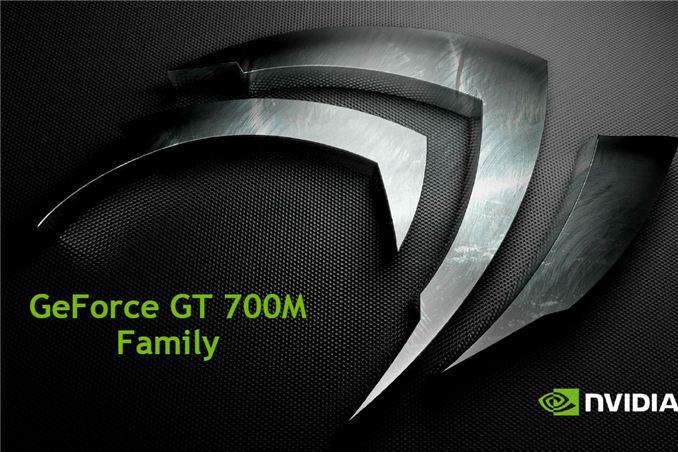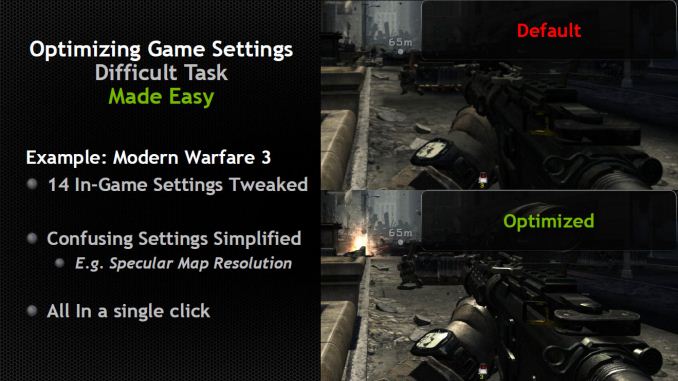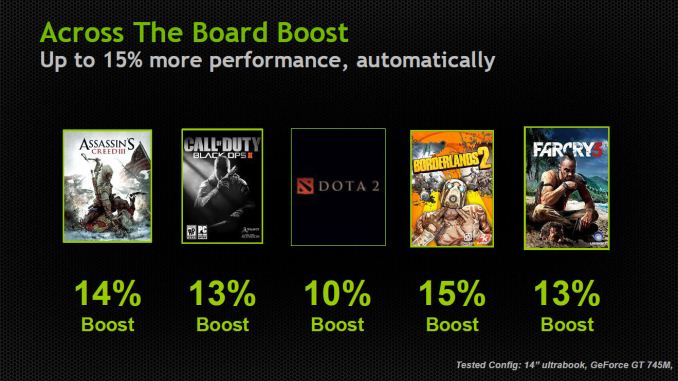NVIDIA’s GeForce 700M Family: Full Details and Specs
by Jarred Walton on April 1, 2013 9:00 AM EST
Introducing the NVIDIA GeForce 700M Family
With spring now well under way and the pending launch of Intel’s Haswell chips, OEMs always like to have “new” parts across the board, and so once more we’re getting a new series of chips from NVIDIA, the 700M parts. We’ve already seen a few laptops shipping with the 710M and GT 730M; today NVIDIA is filling out the rest of 700M family. Last year saw NVIDIA’s very successful launch of mobile Kepler; since that time, the number of laptops shipping with NVIDIA dGPUs compared to AMD dGPUs appears to have shifted even more in NVIDIA’s favor.
Not surprisingly, with TSMC still on 28nm NVIDIA isn’t launching a new architecture, but they’ll be tweaking Kepler to keep it going through 2013. Today's launch of the various 700M GPUs is thus very similar to what we saw with the 500M launch: everything in general gets a bit faster than the previous generation. To improve Kepler NVIDIA is taking the existing architecture and making a few moderate tweaks, improving their drivers (which will also apply to existing GPUs), and as usual they’re continuing to proclaim the advantages of Optimus Technology.
Starting on the software side of things, we don’t really have anything new to add on the Optimus front, other than to say that in our experience it continues to work well on Windows platforms—Linux users may feel otherwise, naturally. On the bright side, things like the Bumblebee Project appear to be helping the situation, so now it's at least possible to utilize the dGPU and iGPU under Linux. As far as OEMs go, Optimus has now matured to the point where I can't immediately come up with any new laptop that has an NVIDIA GPU and doesn't support Optimus; we're now at the point where an NVIDIA equipped laptop inherently implies Optimus support.
The second software aspect is NVIDIA’s GeForce Experience software, which allows for automatic game configuration based on your hardware. You can see the full slide deck in the gallery at the end with a few additional details, but GeForce Experience is a new software tool that’s designed to automatically adjust supported games to the “best quality for your hardware” setting. This may not seem like a big deal for enthusiasts, but for your average Joe that doesn’t know what all the technical names mean (e.g. antialiasing, anisotropic filtering, specular highlighting, etc.) it’s a step towards making PCs more gamer friendly—more like a console experience, only with faster hardware. ;-) GeForce Experience is already in open beta, with over 1.5 million downloads and counting, so it’s definitely something people are using.
Finally, NVIDIA has added GPU Boost 2.0 to the 700M family. This is basically the same as what’s found in GeForce Titan, though with some tuning specific to mobile platforms as opposed to desktops. We’re told GPU Boost 2.0 is the same core hardware as GPU Boost 1.0, with software refinements allowing for more fine-grained control of the clocks. Ryan has already covered GPU Boost 2.0 extensively, so we won’t spend much more time on it other than to say that over a range of titles, NVIDIA is getting a 10-15% performance improvement relative to GPU Boost 1.0.
Moving to the hardware elements, hardware change only applies to one of the chips. GK104 will continue as the highest performing option in the GTX 675MX and GTX 680M (as well as the GTX 680MX in the iMac 27), and GK106 will likewise continue in the GTX 670MX (though it appears some 670MX chips also use GK104). In fact, for now NVIDIA isn’t announcing any new high-end mobile GPUs, so the GTX 600M parts will continue to fill that niche. The changes come for everything in the GT family, with some of the chips apparently continuing to use GK107 while a couple options will utilize a new GK208 part.
While NVIDIA won’t confirm which parts use GK208, the latest drivers do refer to that part number so we know it exists. GK208 looks to be largely the same as GK107, and we’re not sure if there are any real differences other than the fact that GK208 will be available as a 64-bit part. Given the similarity in appearance, it may serve as a 128-bit part as well. Basically, GK107 was never available in a 64-bit configuration, and GK208 remedies that (which actually makes it a lower end chip relative to GK107).













91 Comments
View All Comments
JarredWalton - Wednesday, April 3, 2013 - link
They're so low end that I hardly worry about them. Anyone buying a 710M or GT 720M ought to know what they're getting, and at least they're 28nm.Notmyusualid - Wednesday, April 3, 2013 - link
I used to shake my head when I read comments about supposed 20+ lbs laptops, noise, heat, cost, etc.They are not as noisy, nor as heavy as you think. Sure, if you run wPrime all day, you are going to hear it...if you OpenCL compute, you'll hear the GPUs too.
But nobody is forcing you to buy it, and there is clearly a market out there.
Now I smile at the ignorant comments. Like another posted said, making these big laptops is not hurting you, so why hate?
My M18x R2 gets 5+hrs on discrete graphics (nice for typing reports in airports, when you've no lounge access, and unsure of the batteries current capacity).
On it's dual graphic cards I push 3DMark06 33,500, 3DMark11 11,250+, under Linux, Pyrit crunches 130,000PMK/s - all with NO GPU OVERCLOCKING.
Can YOUR desktop do that? I know of many that can't.
What are valid opinions here, is the confusing GPU-naming-game, that both AMD & Nvidia play.
Forcing many uninformed / incorrect purchases, the world over.
If the average consumer knew what they'd get with GDDR3, and 128bit bus width, they might run a mile. Let alone what architecture might reside beneath... I'd welcome a more consistent naming approach, like BMW, for example. (You can be sure your 550i is gonna smoke a 316i). And I'm not saying that is a perfect system either.
Anyway, like they say on Youtube, "Haters are gonna hate".
Rishi. - Monday, April 22, 2013 - link
ummmmm........yes , its the confusing naming schemes they follow , coupled by somewhat more confusing spec. sheet.!nerd1 - Saturday, April 13, 2013 - link
Samsung released chronos 7 with 8870m, which lasts 10+ hrs, 20mm thick and more powerful than 670M and weighs slightly more than rmbp 15.Mobile gaming really gets awesome.
Rishi. - Monday, April 22, 2013 - link
Yeah , it certainally does.!!!I just wished I had a portable beast with GTX675 ,or around that.!!!
Desktop users gonna hate , though.!!!
karbom - Sunday, April 14, 2013 - link
Hi Jarred. I have a confirmation that acer laptop v3 571g has 730m with 128 bit memory bus bandwidth interface. What do you think about other OEMs like Dell, will they implement the same 128 bit interface or 64 bit interface as specifications tend to differ among OEMs also Notebookcheck.net indicates interface as 128/64 bit.Mr. Bub - Wednesday, April 17, 2013 - link
And here begins the obsolescence of my 6 month old laptop with a GT640m.Rishi. - Monday, April 22, 2013 - link
THe only thing I am pissed off about from Nvidia is that their technical specifications about their mobile dGPUs. I have a hard time finding out the difference b/w some of their cards by looking at the spec. sheet. They all apper to be almost same (unless you consider the clock variations.)!!Overclocking is safe , but only as long as you don't mess with the voltages and step up the clock speed slowly. And its not at all a good idea to push the dGPU around the upper limits.
I don't know much about the newer 700m series , but I used to have two models of Kepler600m series. I overclocked the GT640m to touch the values around a DDR3 GT650m , using a modded vBIOS. The temperature for GPU never exceeded 76C with the help of a powerful cooler at 99% load for several minutes.
Performance was on par with GT650 DDR3.!!! :)
However , for me the major issues was the blazing hot cores of 3610QM.Under 60-75% load for 30mins , it reaches 90C , just like that.!!!! Its probably either a poor thermal paste.
And to those who think the laptops with dGPU are poor performing and are overpriced , " are you new to this world , baby!!!! ?? ". Cause here on Earth , I have never heard of a Notebook which performs better than a Desktop at same price point. You have to pay the price for mobility.!!!
"Haters gonna Hate.!"
sdubyas - Wednesday, April 24, 2013 - link
you see for many consumers, like myself, we appreciate your efforts to interpret what is going on with the the specs of tgese chips. however even with this information i am weary of trying decipher what and when I should actually purchase a machine that is not just a rebrand or fail chip. I got burned on a Toshiba satellite with sli of their 8600M and it was a piece, one that failed in just over two years. anyway, that was 2007 and I said I'd never buy another "gaming laptop" but it's time to try again. would anyone of you recommend a laptop that is already available or will soon be. I am really looking at a 680m as it shold be relevant for a couple of years. however, I really don't have more than 1.5k to burn especially on another fail laptop. I also looked at the macbook but they are running only 650m and I'm not sure when their next gen is forthcoming.here is something I am also considering: http://www.villageinstruments.com/tiki-index.php?p... has anyone looked into the vidock?
Menetlaus - Monday, May 6, 2013 - link
I realize this likely won't be read or replied to, but it would be GREATLY appreciated to have a few laptops reviewed with the 7 hundred series nVidia GPU's prior to the Haswell launch.In my case it would be much easier to compare a Ivy Bridge/660M to IB/750M and finally the to a Haswell/750M in a midrange gaming system rather than skipping the IB/750M step and wondering how much of the change is CPUvsGPU based.
Lenovo had/has some IB/750M gaming laptops for sale (replacing an IB/660M offering) and will likely have a Haswell/750M available shortly after the Haswell launch. MSI also has lines with IB/660M and is likely to be at the haswell mobile launch party.